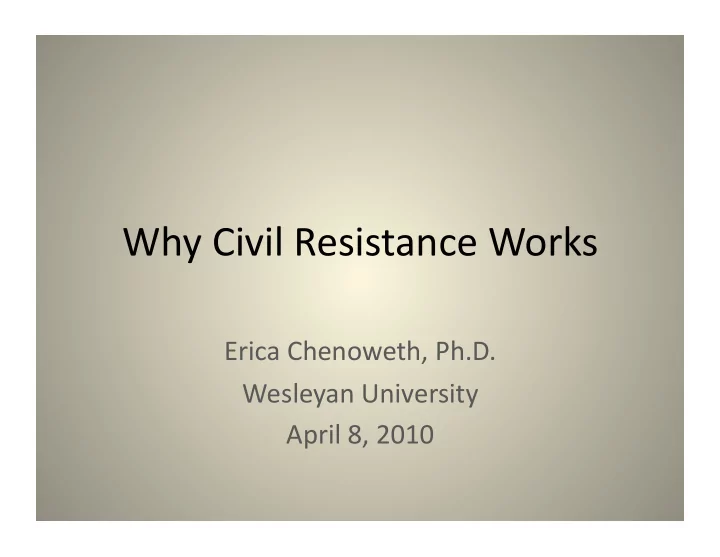

Why Civil Resistance Works Erica Chenoweth, Ph.D. Wesleyan University April 8, 2010
Some ConvenBonal Wisdoms? • Insurgents use violence because – It is effecBve – It is a last resort • Nonviolent resistance – Is ineffecBve against brutal regimes – Is ineffecBve for achieving “tough” demands – Only emerges in contexts where it is likely to succeed in the first place
Project Scope • The Project Does Not: – Explain the emergence of different campaigns – Examine cases outside of the three issue areas (i.e., civil rights, anB‐war, etc.) – Argue that nonviolent campaigns are morally superior to violent campaigns – Establish a formula for campaign success – Focus on the human experience of conflict • Goals of the Project: – Assess the empirical validity of the convenBonal wisdom – Compare trends in the outcomes of nonviolent and violent campaigns – Explore the condiBons under which campaigns succeed and fail – Make some claims about the strategic uBlity of different approaches to poliBcal contestaBon
Introducing NAVCO • Nonviolent and Violent Campaign Outcomes Dataset – 323 campaigns from 1900‐2006 – Ideal types: nonviolent and violent – Campaign goals: regime change, anB‐occupaBon, secession – Unit of analysis: campaign end year – Examples of typical variables • Campaign peak membership • Security force defecBons • Violent government repression • Material support received from a foreign state • Regime type, regime capabiliBes, country populaBon, etc.
Figure 1. Success Rates of Nonviolent and Violent Campaigns, 1900‐2006 70% 60% 50% 40% Nonviolent 30% Violent 20% 10% 0% Success ParBal Success Failure p=.000
Figure 2. Success Rates by Decade, 1940‐2006 70 60 50 Nonviolent 40 Violent 30 20 10 0 1940‐1949 1950‐1959 1960‐1969 1970‐1979 1980‐1989 1990‐1999 2000‐2006 p=.000
The Puzzle Why has nonviolent resistance been more effecBve than violent insurgency in the 20 th century?
The Argument: The Primacy of ParBcipaBon • The superior mobilizaBon capacity of nonviolent campaigns advantages them relaBve to violent campaigns. • Mass, nonviolent acBon is more likely to divide the regime, whereas violent acBon is more likely to unite the regime.
Explaining ParBcipaBon in Nonviolent Resistance • Lower physical barriers • Lower informaBonal barriers • Lower moral barriers • Fewer commitment problems
Figure 1. The Effects of Campaign Type on Campaign ParBcipaBon 9.5 11.5 Nonviolent Campaigns Nonviolent Campaigns Violent Campaigns Violent Campaigns Logged Membership, fitted values Logged Membership, fitted values 12 12 11.5 11 10 9.5 11 10.5 10.5 10 12 11.5 Logged Membership, fitted values 11 10.5 10 9.5 Violent Campaigns Nonviolent Campaigns p=.00
Figure 2. The Effects of Campaign Membership on the Probability of Success p=.02
Figure 3. The Effects of Campaign Membership on the Probability of Security Force DefecBons, by Campaign Type Nonviolent Campaigns log members log members Pr(defect) Pr(defect) Nonviolent Campaigns Violent Campaigns Violent Campaigns 10 15 5 0 10 15 15 10 15 5 10 0 5 .4 .2 5 .6 .8 .4 .2 .8 .6 Violent Campaigns Nonviolent Campaigns .8 .6 Pr(defect) .4 .2 0 5 10 15 5 10 15 log members p=.07
The Effects of Repression • Though repression is quite common against nonviolent and violent campaigns, its effects vary – Violent campaigns facing government repression are less than 20% likely to succeed – Nonviolent campaigns facing repression are over 46% likely to succeed • Backfire ohen results from government repression • The state cannot repress all of the people all of the Bme.
Figure 4. The Effects of Campaign Type on the Probability of Receiving External State Support Pr(Campaign Receives Foreign State Support) Nonviolent Campaigns Nonviolent Campaigns Violent Campaigns Violent Campaigns Pr(Campaign Receives Foreign State Support) 0 .6 .4 .4 .2 .2 0 .6 .6 Pr(Campaign Receives Foreign State Support) .4 .2 0 Violent Campaigns Nonviolent Campaigns
The Consequences of Insurgency • Violent campaigns create “structural violence” long aher the insurgency ends • Nonviolent campaigns are more likely to improve governance and stability – Democracy – Civil peace
Post‐Conflict Regime Type Violent Nonviolent Campaigns Campaigns Probability of Being a Democracy Five Years a;er the 4% 41% Conflict Has Ended P=.000
Post‐Conflict Regime Type, Extant Democracies Only Violent Nonviolent Campaigns Campaigns Probability of Being a Democracy Five Years a;er the 15% 84% Conflict Has Ended P=.000
Post‐Conflict Civil War Onset Violent Nonviolent Campaigns Campaigns Probability of Experiencing a Civil War within Ten 43% 28% Years of the End of the Conflict P=.07
Study LimitaBons • Considers only ideal types – Nonviolent and violent campaigns – Two broad categories of goals • Over‐aggregated unit of analysis – Campaign as the unit of analysis, rather than different tacBcal choices (or non‐events) – Fails to capture the iteraBve nature of the conflict (inter‐group and campaign vs. state interacBons) over Bme. • StaBsBcs show only correlaBon, not causaBon.
Study Extensions • CollecBng panel data from 1900‐2008. • CollecBng daily events data from 1989‐2009. – Textual Analysis by Augmented Replacement InstrucBons (TABARI) • Including many other variables, especially intra‐organizaBonal variables.
QuesBons echenoweth@wesleyan.edu
Recommend
More recommend